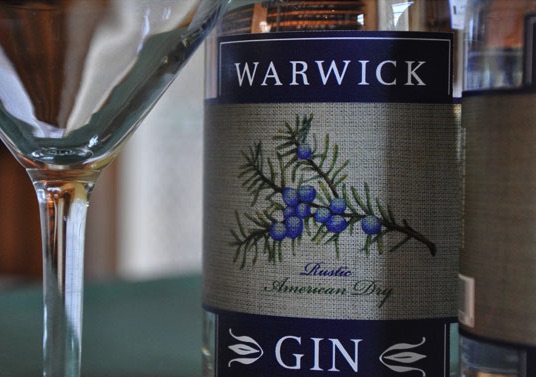Warwick Gin and I: A Tale of Reconciliation
Peter Martin | February 20, 2015
Gin and I haven’t always gotten along. Everyone’s got their albatross and that was mine. Many gins exhibit this almost oily resinousness in taste and sometimes texture, and while I sometimes even enjoyed the flavor, after only the first cocktail my poor stomach would do somersaults. For many years I took that for granted, and with no small amount of consternation. Gin is an amazing liquor that tastes unlike anything else, and its potential as a platform for cocktails is arguably unrivaled. Imagine my heartache then, to watch from afar its boom in popularity knowing in my heart we just weren’t going to be buds. That’s why I approached Warwick Distillery’s Gin with plenty of trepidation.

But first, a little backstory. The town of Warwick has become increasingly well-known throughout the region, particularly for its fertile soil affectionately known as ‘black dirt.’ The owners of what is now Warwick Distillery recognized its quality, and purchased an orchard in 1989 to grow apples and other fruit. They began with hard-cider and a handful of wines, opening their doors to the public in 1994. After much tweaking, they eventually settled on the recipe for Doc’s Draft Hard Cider, which enjoys a lot of praise and popularity throughout the state. They soon began producing fruit brandies, and eventually distilled the gin I found myself approaching so nervously.
At the first sip, however, I knew things were going to be different, not least because the taste was exquisite. Warwick’s Gin is definitely a ‘new-world’ variety, characterized by an emphasis on citrus and floral notes as opposed to piney juniper. This one was unique for being especially mellow. Juniper still dominates the nose and the initial taste but without the aforementioned piney resinousness. I soon realized this gin and I might just patch things up between us. The mid-palate and finish are where it becomes truly unique. From the initial shock of juniper it splinters dazzlingly into about a half dozen constituent components. These secondary flavors are balanced so evenly that to emphasize one over the other it only takes a little focus or concentration. There’s a smoother citrus sitting between a bright herbaceousness and a darker sweetness, all sort of held in suspension with a couple other flavors I’d need more experience to explain. Nonetheless, the variety and balance of these flavors are what makes gin in general – and this one in particular – so great for mixing.
We usually don’t think of using gin in winter drinks, but in a good example like Warwick’s there is a tremendous amount of versatility for doing just that. I decided, after some experimentation, to put together a take on an ancient cocktail we’ll call the Pedro Martinez (HAHA GET IT ?!). It’s essentially a classic Martinez for someone who didn’t have Luxardo lying around and can come up with infinitely, just heart-breakingly clever names for things. It was delicious. Like, think about getting a third bedroom to hoard as much of it as possible delicious. If it were a person I would treat it with loving respect, support, and admiration in the hopes that someday we could get married. Any bad blood between gin and I dissolved instantly, and I knew immediately I’d become a huge fan. Try it for yourself sometime, and visit Warwick’s tasting room to try some of their wines as well. It’s open daily from 11-6, and their wines, ciders, and gins enjoy a fairly wide distribution throughout the region, so look out for them in your local liquor store.
Pedro Martinez:
2 oz. Warwick’s Gin
1 oz. Carpano Classico or other Sweet Vermouth
Approx. ½ tsp. Lemon Juice
1 dash angostura bitters
Lemon Twist for garnish
Combine Gin, Vermouth, and Lemon Juice and stir over ice until chilled. Strain into a glass and add bitters. Twist the lemon peel over the drink and drop it in.
Read On, Reader...
-

Jaime Stathis | February 15, 2024 | Comment The Hudson Valley’s First Via Ferrata at Mohonk Mountain House
-

Ryan Keegan | November 28, 2023 | Comment Hunter, NY: Full Circle
-

Ryan Keegan | October 17, 2023 | Comment Ellenville’s Next Chapter
-

Joan Vos MacDonald | September 28, 2023 | Comment The Reinvisioned Livingston Manor Fly Fishing Club

